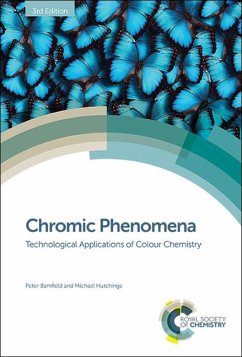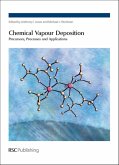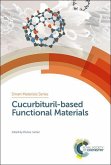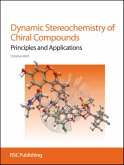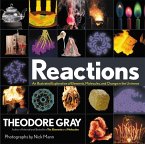- Gebundenes Buch
- Merkliste
- Auf die Merkliste
- Bewerten Bewerten
- Teilen
- Produkt teilen
- Produkterinnerung
- Produkterinnerung
Providing an entry point both for new researchers and established ones, this book develops and investigates new areas where chemicals or materials interact with light to produce colour, a colour change, or luminescence.
Andere Kunden interessierten sich auch für
![Cucurbiturils and Related Macrocycles Cucurbiturils and Related Macrocycles]() Cucurbiturils and Related Macrocycles247,99 €
Cucurbiturils and Related Macrocycles247,99 €![Chemical Vapour Deposition Chemical Vapour Deposition]() Chemical Vapour Deposition262,99 €
Chemical Vapour Deposition262,99 €![Rheology for Chemists Rheology for Chemists]() J W GoodwinRheology for Chemists58,99 €
J W GoodwinRheology for Chemists58,99 €![Cucurbituril-Based Functional Materials Cucurbituril-Based Functional Materials]() Cucurbituril-Based Functional Materials217,99 €
Cucurbituril-Based Functional Materials217,99 €![Dynamic Stereochemistry of Chiral Compounds Dynamic Stereochemistry of Chiral Compounds]() Christian Wolf (USA Georgetown University)Dynamic Stereochemistry of Chiral Compounds68,99 €
Christian Wolf (USA Georgetown University)Dynamic Stereochemistry of Chiral Compounds68,99 €![Reactions Reactions]() Theodore GrayReactions24,99 €
Theodore GrayReactions24,99 €![Electrochemical Membrane Technology Electrochemical Membrane Technology]() Adewale Giwa (Chemical and Water Desalination Engineering ProgramElectrochemical Membrane Technology206,99 €
Adewale Giwa (Chemical and Water Desalination Engineering ProgramElectrochemical Membrane Technology206,99 €-
-
-
Providing an entry point both for new researchers and established ones, this book develops and investigates new areas where chemicals or materials interact with light to produce colour, a colour change, or luminescence.
Hinweis: Dieser Artikel kann nur an eine deutsche Lieferadresse ausgeliefert werden.
Hinweis: Dieser Artikel kann nur an eine deutsche Lieferadresse ausgeliefert werden.
Produktdetails
- Produktdetails
- Verlag: Royal Society of Chemistry
- 3 ed
- Seitenzahl: 812
- Erscheinungstermin: 28. August 2018
- Englisch
- Abmessung: 234mm x 165mm x 48mm
- Gewicht: 1368g
- ISBN-13: 9781782628156
- ISBN-10: 1782628150
- Artikelnr.: 52207682
- Herstellerkennzeichnung
- Libri GmbH
- Europaallee 1
- 36244 Bad Hersfeld
- gpsr@libri.de
- Verlag: Royal Society of Chemistry
- 3 ed
- Seitenzahl: 812
- Erscheinungstermin: 28. August 2018
- Englisch
- Abmessung: 234mm x 165mm x 48mm
- Gewicht: 1368g
- ISBN-13: 9781782628156
- ISBN-10: 1782628150
- Artikelnr.: 52207682
- Herstellerkennzeichnung
- Libri GmbH
- Europaallee 1
- 36244 Bad Hersfeld
- gpsr@libri.de
Dr Peter Bamfield has been involved in colours research and development for over 50 years. Since retiring from full time management in the colour industry, he has maintained an up to date knowledge of the subject area, especially on the newer applications, whilst acting as a freelance consultant to international companies, publishing reviews and presenting papers at colour conferences. He is a Fellow of The Royal Society of Chemistry and a Member of the Society of Dyers and Colourists. He authored a book on Research and Development Management in the Chemical and Pharmaceutical Industry (Wiley-VCH) which has now been published in three editions. Dr Mike Hutchings spent 34 years in research functions in the UK and German chemical industry, mainly in colour-related and computer chemistry areas. For the past 7 years he has been involved in various freelance consultancy roles, some involving colour chemistry and associated businesses, but especially with the Munich company InfoChem on computer aided synthesis developments. He is a Fellow of the Royal Society of Chemistry. His latest applied chemistry interest concerns the cultivation and study of his freshly planted wood of about 2000 native British trees.
Part 1 Colour Change Phenomena and their Applications - Introduction
Photochromism
Thermochromism
Ionochromism: Halochromism, Acidochromism and Metallochromism
Electrochromism
Gasochromism
Solvatochromism
Vapochromism
Mechanochromism
Chromic Phenomena via Aggregation
Miscellaneous Chromisms
Colour Change and Nanoplasmonics
Electrophoretic Displays
Part 2 Luminescent Materials and their Applications - Introduction
Photochromism
Chemiluminescence
Bioluminescence
Electrochemiluminescence
Electroluminescence
Mechanoluminescence
Incandescence
Part 3 Light Processing Materials in Biomedical, Energy and Other Applications - Introduction
Near-Infrared Absorbers and Their Applications
Optical Data Storage
Organic Photoconductors
Photosensitisers
Photosensitisers in Medicine and Chemical Biology
Solar Energy Utilisation
Conversion of Light into Kinetic Energy
Part 4 Light Manipulation Materials, Structural Colours and Photonics
Introduction
Liquid Crystal Materials and Their Uses
Colours from Physical Effects
Holography
Laser Diodes
Nonlinear Optics
Photorefractive Polymers
Organic Chromophores used as Commercial Dyes and Pigments
Increase in the Number of Relevant Scientific Publications
Subject Index
Photochromism
Thermochromism
Ionochromism: Halochromism, Acidochromism and Metallochromism
Electrochromism
Gasochromism
Solvatochromism
Vapochromism
Mechanochromism
Chromic Phenomena via Aggregation
Miscellaneous Chromisms
Colour Change and Nanoplasmonics
Electrophoretic Displays
Part 2 Luminescent Materials and their Applications - Introduction
Photochromism
Chemiluminescence
Bioluminescence
Electrochemiluminescence
Electroluminescence
Mechanoluminescence
Incandescence
Part 3 Light Processing Materials in Biomedical, Energy and Other Applications - Introduction
Near-Infrared Absorbers and Their Applications
Optical Data Storage
Organic Photoconductors
Photosensitisers
Photosensitisers in Medicine and Chemical Biology
Solar Energy Utilisation
Conversion of Light into Kinetic Energy
Part 4 Light Manipulation Materials, Structural Colours and Photonics
Introduction
Liquid Crystal Materials and Their Uses
Colours from Physical Effects
Holography
Laser Diodes
Nonlinear Optics
Photorefractive Polymers
Organic Chromophores used as Commercial Dyes and Pigments
Increase in the Number of Relevant Scientific Publications
Subject Index
Part 1 Colour Change Phenomena and their Applications - Introduction
Photochromism
Thermochromism
Ionochromism: Halochromism, Acidochromism and Metallochromism
Electrochromism
Gasochromism
Solvatochromism
Vapochromism
Mechanochromism
Chromic Phenomena via Aggregation
Miscellaneous Chromisms
Colour Change and Nanoplasmonics
Electrophoretic Displays
Part 2 Luminescent Materials and their Applications - Introduction
Photochromism
Chemiluminescence
Bioluminescence
Electrochemiluminescence
Electroluminescence
Mechanoluminescence
Incandescence
Part 3 Light Processing Materials in Biomedical, Energy and Other Applications - Introduction
Near-Infrared Absorbers and Their Applications
Optical Data Storage
Organic Photoconductors
Photosensitisers
Photosensitisers in Medicine and Chemical Biology
Solar Energy Utilisation
Conversion of Light into Kinetic Energy
Part 4 Light Manipulation Materials, Structural Colours and Photonics
Introduction
Liquid Crystal Materials and Their Uses
Colours from Physical Effects
Holography
Laser Diodes
Nonlinear Optics
Photorefractive Polymers
Organic Chromophores used as Commercial Dyes and Pigments
Increase in the Number of Relevant Scientific Publications
Subject Index
Photochromism
Thermochromism
Ionochromism: Halochromism, Acidochromism and Metallochromism
Electrochromism
Gasochromism
Solvatochromism
Vapochromism
Mechanochromism
Chromic Phenomena via Aggregation
Miscellaneous Chromisms
Colour Change and Nanoplasmonics
Electrophoretic Displays
Part 2 Luminescent Materials and their Applications - Introduction
Photochromism
Chemiluminescence
Bioluminescence
Electrochemiluminescence
Electroluminescence
Mechanoluminescence
Incandescence
Part 3 Light Processing Materials in Biomedical, Energy and Other Applications - Introduction
Near-Infrared Absorbers and Their Applications
Optical Data Storage
Organic Photoconductors
Photosensitisers
Photosensitisers in Medicine and Chemical Biology
Solar Energy Utilisation
Conversion of Light into Kinetic Energy
Part 4 Light Manipulation Materials, Structural Colours and Photonics
Introduction
Liquid Crystal Materials and Their Uses
Colours from Physical Effects
Holography
Laser Diodes
Nonlinear Optics
Photorefractive Polymers
Organic Chromophores used as Commercial Dyes and Pigments
Increase in the Number of Relevant Scientific Publications
Subject Index

